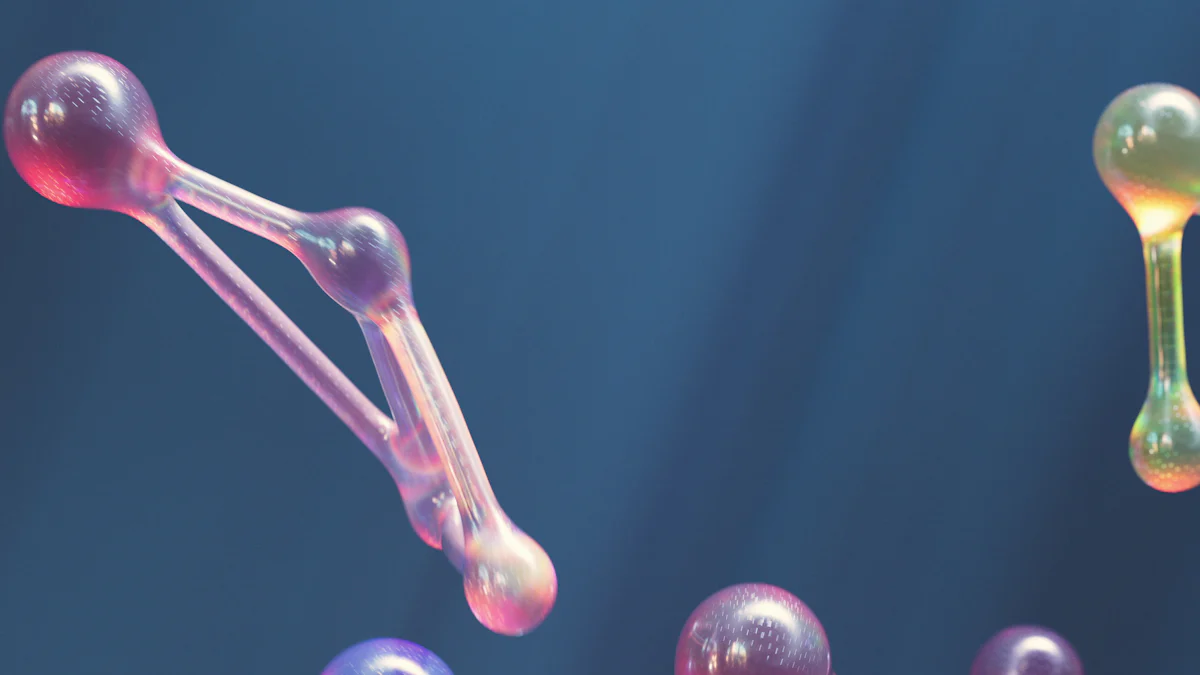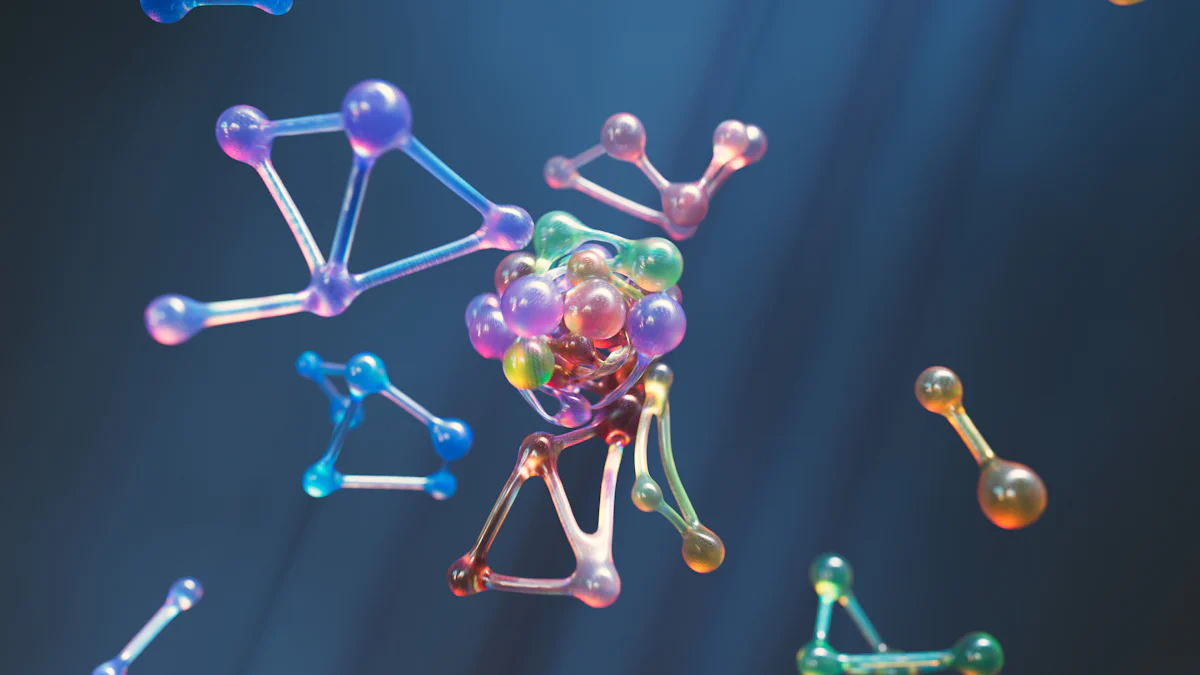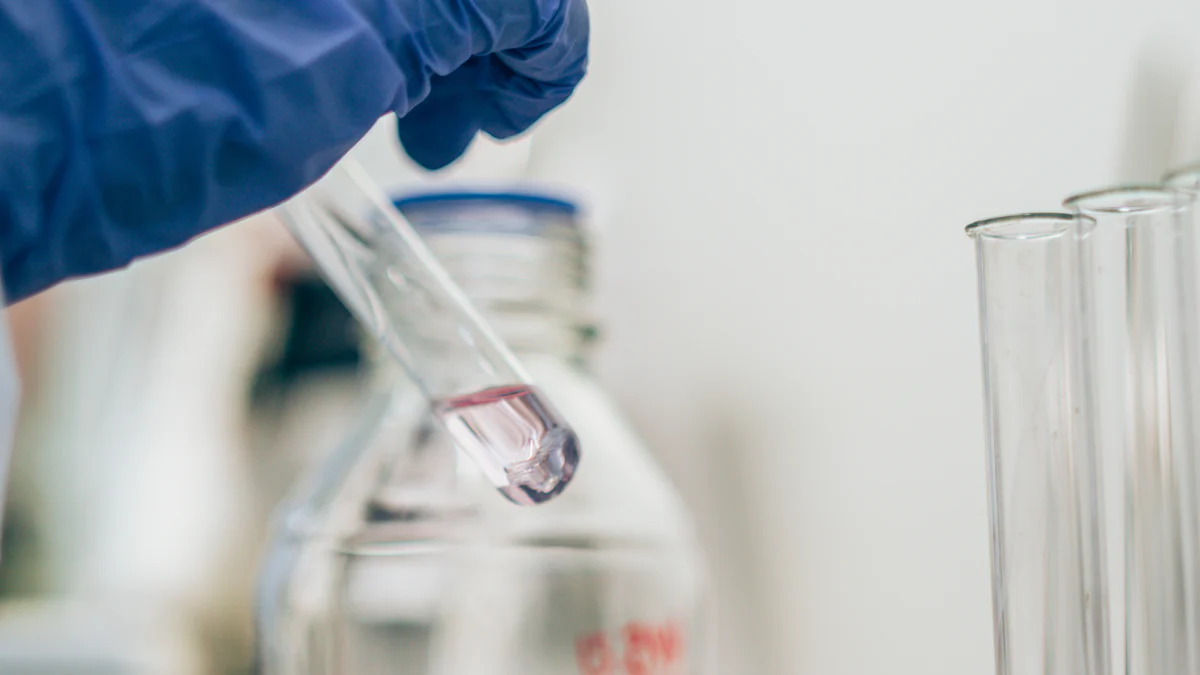
L-Cystine plays a pivotal role in maintaining cellular health and functionality. It contributes to redox balance by participating in glutathione synthesis, a process essential for combating oxidative stress. This compound also supports protein stability through disulfide bond formation, ensuring proper folding and structural integrity. Furthermore, it aids in synthesizing critical biomolecules like coenzyme A and S-adenosyl methionine. Studies reveal its involvement in oxidative stress resistance, as seen in Burkitt's Lymphoma cells and lung cancer cells, where it enhances survival under stress conditions.
For more information on related products, visit https://www.nb-chenrun.com/products.
Key Takeaways
- L-Cystine helps keep cells healthy by balancing redox and fighting damage.
- It strengthens proteins by forming disulfide bonds, helping them work well and last longer.
- You can get L-Cystine from foods like meat and dairy, which suit many diets.
Understanding L-CystineChemical Properties and Formation
L-Cystine stands out in biological systems due to its unique chemical properties. Its sulfur content enables the formation of disulfide bonds, which are critical for maintaining protein structure and function. These bonds stabilize the three-dimensional configuration of proteins, ensuring their proper activity. L-Cystine forms through the oxidation of two L-Cysteine molecules, demonstrating the dynamic interchangeability between these two forms in cellular environments. This reversible process plays a vital role in redox balance, allowing cells to adapt to oxidative stress.
The natural formation of L-Cystine begins with cysteine synthesis. Enzymes such as cystathionine beta synthase and cystathionine gamma-lyase catalyze the conversion of precursors into cysteine. These enzymatic reactions highlight the biochemical pathways that sustain sulfur-containing amino acid production. The table below outlines the primary precursors and their respective pathways:
| Precursor | Pathway Description |
|---|---|
| L-Methionine | Cysteine can be produced via the reverse transsulfuration pathway from L-methionine. |
| L-Serine | Cysteine can also be synthesized from L-serine through acetylation and subsequent sulfhydration. |
Biological Availability and Natural Sources
L-Cystine is widely available in nature, primarily through dietary sources. Protein-rich foods such as meat, eggs, and dairy products provide significant amounts of this amino acid. Plant-based sources, including legumes, nuts, and seeds, also contribute to its availability, making it accessible to individuals with diverse dietary preferences. Once ingested, L-Cystine undergoes digestion and absorption in the small intestine, where it enters the bloodstream for cellular uptake.
In cellular systems, specialized transporters facilitate the movement of L-Cystine across membranes. These transporters ensure its efficient delivery to tissues requiring high levels of sulfur-containing amino acids. For instance, rapidly dividing cells, such as those in the immune system, rely on L-Cystine to support their metabolic demands. This availability underscores its importance in maintaining cellular health and function.
L-Cystine in Cellular Functions

Role in Redox Balance and Oxidative Stress
L-Cystine plays a critical role in maintaining redox balance and protecting cells from oxidative stress. It serves as a precursor for glutathione synthesis, a key antioxidant that neutralizes reactive oxygen species (ROS) and prevents cellular damage. Studies on Escherichia coli reveal that L-Cystine transporters, such as YdjN and FliY-YecSC, are essential for importing L-Cystine into the cytoplasm. This process facilitates the reduction of hydrogen peroxide to water, mitigating oxidative damage to cellular components. Disruption of these transporters leads to increased lipid peroxidation, highlighting the importance of L-Cystine in cellular defense mechanisms.
Additionally, under oxidative stress caused by hydrogen peroxide, E. coli induces genes that utilize periplasmic glutathione as a source of L-Cysteine. This mechanism underscores the adaptability of cells in using L-Cystine to combat oxidative stress effectively. Supplementation with L-Cystine has also been shown to restore glutathione synthesis, improving redox balance and reducing oxidative stress.
Contribution to Protein Structure and Stability
L-Cystine contributes significantly to protein stability and folding through the formation of disulfide bonds. These bonds, formed by the oxidation of cysteine residues, are crucial for maintaining the tertiary structure of proteins. Proteins secreted into the extracellular environment particularly benefit from these bonds, as they enhance rigidity and resistance to proteolytic degradation. By stabilizing the three-dimensional structure, L-Cystine ensures proper protein function and longevity, which is vital for cellular processes.
Involvement in Metabolic Pathways and Detoxification
L-Cystine plays a pivotal role in metabolic pathways and detoxification processes. It participates in a shuttle system that regulates hydrogen peroxide levels, preventing oxidative damage. The table below highlights its roles:
| Role of L-Cystine in Metabolic Pathways and Detoxification Processes | Description |
|---|---|
| Involvement in oxidative stress management | L-Cystine is part of a shuttle system that regulates hydrogen peroxide levels in Escherichia coli. |
| Protection against lipid peroxidation | It prevents lipid peroxidation, thus protecting cellular membranes. |
| Transport mechanisms | Two transporters, YdjN and FliY-YecSC, facilitate the uptake and export of L-Cystine, crucial for detoxification. |
| Detoxification process | The shuttle system reduces hydrogen peroxide to water, preventing oxidative damage. |
These roles emphasize the importance of L-Cystine in maintaining cellular health and protecting against environmental stressors.
Key Scientific Studies on L-CystineResearch on Redox Homeostasis and Glutathione Synthesis
L-Cystine plays a central role in regulating redox homeostasis through its involvement in glutathione (GSH) synthesis. GSH, a critical antioxidant, protects cells from oxidative damage and regulates pathways like mTORC1 signaling. Research highlights that cystine deprivation significantly reduces intracellular GSH levels, with a 50% decline observed within nine hours. Supplementing cystine restores GSH levels, confirming its essential role in maintaining cellular redox balance.
"Cystine appeared to be the main regulator of GSH homeostasis, since cystine deprivation alone reduced intracellular GSH and it was not further aggravated by depletion of other amino acids. Consistently, cystine supplementation alone was sufficient to sustain intracellular GSH in the absence of other amino acids."
This evidence underscores the importance of L-Cystine in sustaining GSH metabolism and its broader impact on cellular signaling and oxidative stress management.
Studies on Protein Folding and Cellular Stability
L-Cystine contributes to protein folding and stability by forming disulfide bonds. These bonds stabilize the three-dimensional structure of proteins, ensuring proper function and resistance to degradation. Proteins secreted into extracellular environments particularly benefit from this stabilization. Studies reveal that L-Cystine’s role in protein folding extends to maintaining cellular stability under stress conditions. By enhancing protein integrity, it supports critical cellular processes and prevents dysfunction caused by misfolded proteins.
Findings on Immune Function and Disease Prevention
L-Cystine demonstrates significant potential in immune function and disease prevention. It reduces oxidative stress and improves immune responses, particularly in conditions like chronic hepatitis C and acute liver failure. The table below summarizes its contributions to various diseases:
| Disease | Contribution of L-Cystine |
|---|---|
| Cardiovascular diseases | Prevention and reduction of plasma homocysteine levels |
| Chronic hepatitis C | Increases glutathione and improves treatment response |
| Acute liver failure | Reduces IL-17 levels |
| Nephropathic cystinosis | Reduces oxidative stress and improves renal function |
| Noise-induced hearing loss | Provides protective effects against hearing loss |
| Cocaine addiction | Acts as an anti-relapse agent in abstinent subjects |
These findings highlight L-Cystine’s therapeutic potential in addressing oxidative stress-related diseases and enhancing overall health.
Applications of L-Cystine in Health and Biotechnology

Therapeutic Potential in Medicine
L-Cystine has demonstrated remarkable therapeutic applications across various medical fields. Its antioxidant properties make it a valuable agent in reducing oxidative stress and improving cellular health. In cardiovascular medicine, it lowers plasma homocysteine levels, reducing the risk of heart disease. It enhances glutathione synthesis in patients with chronic hepatitis C, improving their response to interferon treatments. In acute liver failure, it regulates immune activity by reducing IL-17 levels, aiding recovery.
The table below highlights its diverse therapeutic applications:
| Therapeutic Application | Effect |
|---|---|
| Prevention of cardiovascular diseases | Reduction of plasma concentrations and homocysteine levels |
| Treatment of chronic hepatitis C | Increase in glutathione and improvement in response to interferon |
| Treatment of acute liver failure | Reduced IL-17 levels |
| Treatment of nephropathic cystinosis | Reduced oxidative stress and improved renal function |
| Treatment of noise-induced hearing loss | Protective effect. Hearing loss is reduced |
| Treatment of oxidative stress during aging | Increased synthesis of glutathione and decreased oxidative stress |
| Treatment of type-2 diabetes | Increased glutathione and decreased triglyceride levels |
| Improvement of well-trained athletes’ performance | Restoration of Natural Killer cell activity |
These applications underscore its potential in addressing oxidative stress-related conditions and improving overall health.
Advances in Biotechnology and Metabolic Engineering
Biotechnology has leveraged L-Cystine to enhance metabolic engineering and industrial production. Scientists have optimized biosynthetic pathways in microorganisms like Escherichia coli and Corynebacterium glutamicum to improve L-Cystine yields. Key advancements include:
- Enhancing L-cysteine biosynthesis by expressing genes encoding feedback inhibition-insensitive enzymes like phosphoglycerate dehydrogenase (PGDH).
- Weakening L-cysteine degradation by knocking out genes encoding L-cysteine desulfhydrase (CD).
- Strengthening efflux systems while reducing import mechanisms to increase intracellular L-Cystine availability.
These strategies have enabled the efficient fermentative production of L-Cystine, which is now widely used in pharmaceuticals, food, animal feed, and cosmetics. Enzymatic processes and purification techniques have further industrialized its production, ensuring safety and environmental sustainability.
Future Directions for Research and Development
Emerging research highlights the growing demand for L-Cystine in pharmaceuticals, nutraceuticals, and personalized medicine. Its inclusion in drug formulations aims to reduce acetaldehyde levels, benefiting patients with alcohol-related conditions. The cosmetics industry has embraced its use in skin and hair care products due to its role in strengthening keratin structures.
Future studies should focus on optimizing microbial production techniques and exploring its applications in natural product-based medicines. Researchers are also investigating its potential as a flavoring and chelating agent in the food industry. These developments could unlock new opportunities for L-Cystine in health and biotechnology, paving the way for innovative therapies and sustainable production methods.
Challenges in L-Cystine ResearchIssues with Bioavailability and Transport Mechanisms
Understanding the bioavailability and transport mechanisms of L-Cystine presents significant challenges. The limited number of transport proteins responsible for importing L-Cystine into cells complicates this process. Variations in cell membrane structures across bacterial strains further hinder the study of these mechanisms. Researchers face difficulties in identifying how these transport systems function under different environmental conditions.
The regulation of L-Cystine transport systems adds another layer of complexity. Cells must balance the import of L-Cystine with its metabolic demands, which vary depending on stress levels and growth phases. Additionally, the metabolic pathways involved in L-Cystine production interact with other cellular processes, making it harder to isolate their specific roles. These factors collectively obscure a clear understanding of how L-Cystine is absorbed and utilized within biological systems.
The intricate interplay between transport proteins, membrane variability, and metabolic regulation highlights the need for advanced research tools to unravel these complexities.
Gaps in Current Knowledge and Research Limitations
Despite its biological importance, several gaps remain in L-Cystine research. Scientists lack comprehensive data on how L-Cystine functions in different cell types and tissues. Most studies focus on specific organisms or conditions, leaving broader applications unexplored. For instance, the role of L-Cystine in non-model organisms or under extreme environmental conditions remains poorly understood.
Another limitation involves the tools available for studying L-Cystine. Current methods often fail to capture its dynamic behavior in real-time. Advanced imaging techniques and molecular probes could provide deeper insights but remain underutilized. Furthermore, the interplay between L-Cystine and other sulfur-containing compounds requires more investigation to clarify its full range of functions.
Addressing these gaps will require interdisciplinary approaches, combining biochemistry, molecular biology, and computational modeling to advance the field.
L-Cystine plays a vital role in cellular systems, particularly in oxidative stress resistance and protein stability. Its transporters in E. coli prevent lipid peroxidation by reducing hydrogen peroxide, showcasing its importance in cellular defense. Disruption of these systems leads to increased oxidative damage, emphasizing its protective functions.
Applications of L-Cystine extend to health and biotechnology. It enhances antioxidant defenses, supports respiratory health, and strengthens keratin structures in hair. Its potential to reduce arterial stiffness and acetaldehyde exposure highlights its therapeutic promise. Continued research could unlock innovative uses in personalized medicine and sustainable biotechnological solutions.
Advancing our understanding of L-Cystine will pave the way for breakthroughs in health and industrial applications, benefiting both science and society.
FAQWhat is the primary function of L-Cystine in cellular systems?
L-Cystine supports redox balance, protein stability, and detoxification. It acts as a precursor for glutathione synthesis, protecting cells from oxidative stress and maintaining structural integrity.
How does L-Cystine contribute to protein stability?
L-Cystine forms disulfide bonds, stabilizing protein structures. These bonds ensure proper folding, enhance resistance to degradation, and maintain protein functionality in extracellular environments.
Can L-Cystine supplementation improve health?
Yes, L-Cystine supplementation enhances antioxidant defenses, supports immune function, and reduces oxidative stress. It shows therapeutic potential in cardiovascular health, liver conditions, and age-related oxidative damage.
Media Contact
Company Name: Ningbo Yuanfa Bioengineering Co., Ltd.
Email:Send Email
Country: China
Website: https://www.nb-chenrun.com/
